AVIVA-Berlin >
Interviews
AVIVA-BERLIN.de im Dezember 2025 -
Beitrag vom 27.06.2016
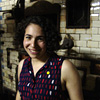
Interview with Eve Neiger
Sharon Adler
Eve Neiger, born 1987 in Chicago, Illinois, USA, is an archivist, designer and visual artist. Until September 1933, Eve´s grandfather, Isaak "Itschu" Neiger, lived at Auguststraße 10, where the family had a kosher bakery. Eve grew up looking at ...
... his grandfather´s childhood photographs and listening to his stories about his life during World War II. Her career as a photograph archivist grew from an interest in historic photographs and the personal stories they reveal.
Her experience as an artist and researcher has fostered a lifelong interest in historic photographs and the personal stories they reveal. As a visual media archivist and preservation specialist her goal is to increase the public´s exposure to the valuable information stored in archives and special collections by increasing awareness, enabling access, and preserving archival material for future users.
She is currently working as a visual materials archivist at Yale University´s Beinecke Rare Book and Manuscript Library after earning a Master of Science in Information degree from the University of Michigan School of Information. Her archival work focuses on processing and cataloging visual materials collections as well as historic photograph preservation. She earned her BA in German from Brandeis University and her M.S. in Information from the University of Michigan.
Sharon Adler from AVIVA-Berlin met Eve Neiger in AuguststraĂźe 10 after the booklaunch of " KuLe Kunst & Leben / Art & Life. A House in Berlin-Mitte since 1990. Ein Haus in Berlin-Mitte seit 1990":
AVIVA: How much did you learn and experience about your German origin and biographic background when you grew up? Has the Shoah been always an issue or was it more like a taboo in your family narrative?
Eve Neiger: I was always aware of the Shoah and my grandfather´s identity as a survivor. I grew up in a reform Jewish community in the Chicago suburbs and attended Jewish day school at Solomon Schechter Day School from kindergarten through 8th grade. Holocaust education was always part of the school curriculum and I can´t remember a time when I didn´t know about the Holocaust. In sixth grade we studied Holocaust memoirs and I began to read all the Holocaust memoirs I could find. I was very interested in learning about personal accounts of experiences during the Holocaust, possibly to find a better understanding of history and also of my own heritage. As a very young child, I remember listening to my grandfather Itschu and his sister Paula speak in French (and possibly German). I knew that he had come from Germany, spoke many languages, and had lived in many countries while on the run from Hitler. I also knew, from a very young age, that his sister Fanny had been killed in Auschwitz, because her portrait stood in a place of prominence on his dresser. The act of remembrance, and especially Holocaust remembrance, is an integral part of Jewish culture, in holiday ritual, in prayer, and in community building, and was therefor a key part of my early education as well.
I always knew that my grandfather was born in Germany. It was never hidden or taboo in my family. Instead it was a key part of our identity. My father studied German in school and when I began high school, I also decided to study German, instead of the Hebrew I had been studying since kindergarten. I was interested in learning more about my German origins and wanted to connect with Itschu. I was excited to speak German with him and explore that part of his life. As I studied German, I also began to ask Itschu more questions about his life and I slowly learned all the details of his story. Through coursework in school - documentary filmmaking, German history, and coursework on "der Schuldfrage" - I began to delve deeper and deeper into the Neiger family story. I also explored the papers and photographs that my grandfather had saved from him life and seeing the information and context they gave to my grandfather´s story, I was inspired to become an archivist.
AVIVA: Which impact did it have on you when you were a child looking at your grandfather´s childhood photographs and listening to his stories about his life and survival during World War II?
Eve Neiger: To a child with a very small world-view, it was amazing to hear that my grandfather had traveled so much and experienced so much tragedy. I had learned about the Holocaust in school, and had seen books and movies, and Itschu´s story of survival made me feel deeply connected to the history of the Holocaust, and of World War II. In a way, I think it also made me more appreciative, at an unusually young age, of the freedom we have in America to live safely as Jews and practice our religion freely. I think I have always been aware of how easily this privilege can be lost.
AVIVA: Is this the reason which made you become an artist and photograph archivist? In your archival work you focus on processing and cataloging visual materials collections as well as historic photograph preservation. What is for you the biggest challenge regarding your interest in historic photographs and the personal stories they reveal?
Eve Neiger: My experience with the old photographs in my grandfather´s album, seeing how they really told a story about his life, is part of the reason I became a photo archivist. There are a few photos of him playing with his sister Fanny in the courtyard of Auguststraße 10, which really reveal the sweetness, playfulness, and love in their relationship. I always heard from Itschu that Fanny was his favorite sister and that they were very close. But it wasn´t until seeing these photos that I really understood and could relate to this relationship. That is the power of images. In many ways I think they can convey information directly to our deepest understanding in a way that words cannot. This also leads to my greatest challenge in working with archival photographs. It is my job as an archivist to describe the photographs, and other archival material, in archival collections in a way that make them accessible to the public. I describe material so people can find them easily. However there is a fine line between objective description and subjective interpretation. That is my greatest challenge. I need to know when to trust my archivist´s judgment of the facts relayed in the photograph, and when to hold back my own interpretation so others can find their own meaning and understanding of an image.
| 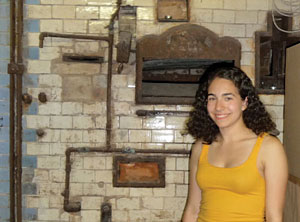 |
© Neiger Familienarchiv. Eve Neiger in der Backstube Auguststraße 10, 2009 |
AVIVA: You came to Berlin for the first time in 1998 to visit ´Auguststraße 10´ - together with your sister (Arielle), your mother (Carol), your father (Carmi), your grandmother (Shirley), and most of all: your grandfather Isaak/ Yitzhak "Itschu" Neiger.
What were your expectations, what are your memories?
Eve Neiger: I really don´t remember what my expectations were at the time, but I remember being excited, mostly because we were going to go to Amsterdam to see the Anne Frank house after Berlin. I was very interested in Holocaust memoirs at the time and, as a voracious reader, was reading many books about individual experiences during the Holocaust, including ´The Diary of a Young Girl´ which I had read a few times. My memories of the trip itself include mostly snippets until we saw Itschu´s neighborhood and Auguststraße 10. I remember lots of rain in Berlin, really good chocolate, eating at Mövenpick, and lots of interesting graffiti. It was my first time out of the USA and I think I was overwhelmed by the new smells, and sites, and experiences, and of course the really fantastic ice cream (I was eleven, after all).
| 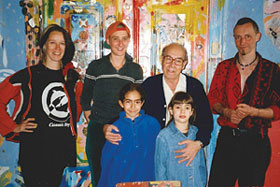 |
Zu Besuch im Kunsthaus KuLe: (von links nach rechts): HeikeMaria unVORSTellBAR, Ursula Maria Berzborn, Eve Neiger, Izak Neiger, Arielle Neiger, Jörg Heuer, 1998 |
I have very vivid memories of walking through Itschu´s neighborhood in Berlin and seeing his house at Auguststraße 10, most of which I wrote about in "KuLe. Kunst & Leben. Ein Haus in Berlin-Mitte seit 1990".
AVIVA: How did it feel to see the bakery and all the other places like your grandfather´s school for the very first time? You were 11 years old, which impact did this experience have to your (future) life?
Eve Neiger: It was really amazing to see all these landmarks of Itschu´s early life. I think, in a way, his memories and stories that I had heard previously were similar to the Holocaust memoir books I was reading. They were real but not so alive, and I couldn´t really relate as a young kid growing up in a privileged life in the US. However, I think seeing all these sites in Berlin, made it all come alive. It was like I had stepped into one of my books and was suddenly living in the story. When we walked through Auguststraße 10 and saw, for the first time, the baker´s oven in the basement. All the adults were overcome with emotion. They all began to cry as my grandfather told stories about his childhood that the sight of the oven and the house were bringing back for him. I don´t think I had ever seen adults cry like this, overcome with emotion of an experience, not because they were sad, but because they were experiencing a powerful moment. I think that is what really impacted me: the power that memory and living history can have on us. I was also aware of how rare it was that we were able to return to Itschu´s childhood home, something that very few survivors were ever able to do.
|  |
© Neiger Familienarchiv. Paula Neiger, vor dem ehemaligen Bäckerladen, Auguststraße 10, 1971 |
AVIVA: What does ´Auguststraße 10´ mean to you personally?
Eve Neiger: Auguststraße 10 an important symbol, for our family, of where we came from, and the place that my grandfather´s bakery held in their community. It is also in some ways a receptacle of my grandfather´s memories, because it had so much power to pull out memories that had been hidden for so long. The community at the KuLe also has immense importance because they are a symbol of welcoming spirit, of creative energy and empowerment, and of a community that values and respects their place in history and those that came before them. It is good when a family is interested in their own history, but for a group of strangers to embrace, value, and show interest in that history as well? That is a very special thing.
|  |
2016: Eve Neiger in front of the oven in the bakery, Auguststraße 10 © AVIVA-Berlin, Sharon Adler |
AVIVA: What does ´Auguststraße 10´ mean to you as a historian?
Eve Neiger: I think buildings can be archives also. A building has stood through many residents, events, wars, and the changes of the world. Buildings can reveal a great deal about history, you just have to ask them. The KuLe has made many changes to the Auguststraße 10, but have also preserved a lot of what they found their in 1990, things that were preserved because of the building´s location in East Berlin. There is so much we can learn from it, not only about the history of the KuLe community, but also about the history of our family, or the neighborhood, and of Berlin. It stands as an artifact of the past and a reflection for the continually changing world around it, and that makes it a very important record of history.
AVIVA: Did you ever visit the grave/cemetery of Chaim und Dvora in Israel?
Eve Neiger: Yes. In 2007 my parents and sister and I went to Israel to visit our cousins, the children, grandchildren, and great-grandchildren of my grandfather´s brother Jacob. My parents had both been to Israel before, but it was my first visit. Chaim and Dvora Neiger are buried in a cemetery on a hill in Haifa. It was very powerful to visit their graves, again, like the visit to Auguststraße 10, because it connected a physical place with stories and made them more real for me. Seeing their graves made me feel more connected to my family and especially to Itschu.
AVIVA: Can you please tell us about your grandfather´s suffering of not being able to rescue his sister Fanny, who was killed by the Nazis September 14th 1942 in Auschwitz?
Eve Neiger: I believe that Paula and Jenny also felt a deep sense of guilt for Fanny´s death. I never knew Jenny but Paula spoke about her guilt in her video testimony for Steven Spielberg´s Shoah Foundation project.
In many ways, this guilt is to be expected, and is very common: Survivor´s Guilt. But I think in this case, Itschu felt that he had brought Fanny back to France because it was his desire to go, to finish his schooling, not hers. Paula, in turn, felt guilty because she had encouraged them to come.
Itschu always felt that it was really his fault that Fanny ended up in Auschwitz. It may be that because he was the brother, he felt that it was his job to protect her. He carried this guilt with him his whole life and didn´t talk about it much but I understood that it was there. It was very difficult for him to come to terms with this guilt so I believe he just continued to carry it with him and honored his sister Fanny by speaking about her frequently and remembering her.
|  |
© Neiger Familienarchiv. Izak und Fanny Neiger, Hof Auguststraße 10, 1932 |
AVIVA: Your family was forced to sell the bakery for very little money. Did your family ever receive restitution, "Wiedergutmachung"?
Eve Neiger: My great-grandfather and great-grandmother Chaim and Dvora Neiger did not received restitution because they died in Haifa in 1937, long before the end of the war. However, their oldest son, Jacob, my grandfather´s older brother, did receive some restitution from the German government because when he left Berlin he was a prosperous baker with a promising career. Paula, my grandfather´s sister, who was a few years younger than Jacob also received a small amount because she and her husband at the time lost their livelihood and a full household of furnishings and personal belongings. Since my grandfather was still a young boy, only fourteen, when he left Berlin, he did not receive any restitution and did not seek any.
| 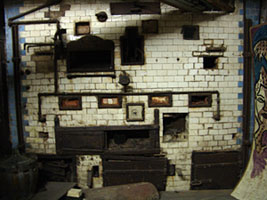 |
© AVIVA-Berlin, Sharon Adler |
AVIVA: The title of your essay in the book "Art & Life. A House in Berlin-Mitte since 1990" is "Memory found at Auguststraße 10: The Life Story of Itschu Neiger, the Baker´s Son" and the title of your lecture on Friday 3 June is "In heritage: Deriving meaning and building connections from memory, place, and the historical record". What is for you the most important issue in passing on personal memories as well as images to the next generation/s regarding understanding of history?
Eve Neiger: I think it is simply that personal lived experiences are much more relatable and easier to understand than broader political history or national history told from the point of view of an objective historian. We are feeling creatures and memories have feelings and emotions that we can relate to. Memories, especially told by people we love and care for, make history come alive and have a greater power to convey understanding than a simple recitation of facts. They also can make us recognize moments in our own lives that reflect past events, and encourage us to stand up and participate in history as it unfolds, creating our own memories, that can, in turn be passed on the next generation.
| 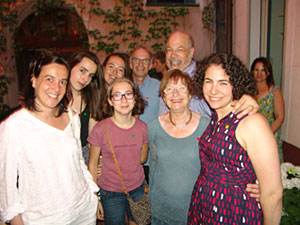 |
Eve Neiger and her Family, June 3rd, 2016 © AVIVA-Berlin, Sharon Adler |
More info at:eveneiger.comStiftung Denkmal fĂĽr die ermordeten Juden Europas
www.stiftung-denkmal.de/enUSC Shoah Foundation
sfi.usc.eduFortunoff Video Archive for Holocaust Testimonies at Yale
web.library.yale.eduRead more at AVIVA-Berlin:Dedications. Festival zur Publikation des Buchs - KuLe Kunst & Leben / Art & Life. A House in Berlin-Mitte since 1990. Ein Haus in Berlin-Mitte seit 1990Das Kunsthaus KuLe in der Auguststraße 10 verbindet seit über 25 Jahren Kunst und Leben. Zum Booklaunch am 3. Juni 2016 waren Carmi und Eve Neiger aus den USA, Nachfahren der jüdischen Familie, die dort bis 1933 eine koschere Großbäckerei betrieb, zu Gast.

KuLe. Kunst & Leben. Ein Haus in Berlin-Mitte seit 1990 / Art & Life. A House in Berlin-Mitte since 1990
Herausgeberinnen: Ursula Maria Berzborn, Steffi Weismann
Verlag: Revolver Publishing
396 Seiten, 100 Seiten in Farbe, 485 Abbildungen, deutsch/engl.
39 € Ladenpreis
35 €
Weitere Informationen zum Kunsthaus KuLe und zum Buch finden Sie unter:www.kunsthauskule.de und
www.revolver-publishing.com